mobile View, to the German Version tap the flag


- Tuvalu Islands
- parliamentary monarchy with the British monarch as chief of state
- former name: Ellice Islands
• Flags
• Historical Flags
• Meaning/Origin of the Flag
• Coat of Arms
• Meaning/Origin of the Coat of Arms
• Map
• Numbers and Facts
• History
• Origin of the Country's Name
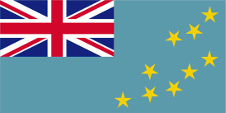
National and merchant flag,
ratio = 1:2,
Source, by: Flags of the World





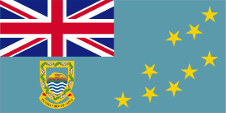
State flag,
ratio = 1:1,
Source, by: Flags of the World



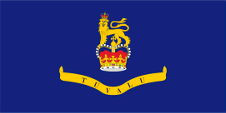
Flag of the Governor General,
ratio = 1:2,
Source, by: Flags of the World




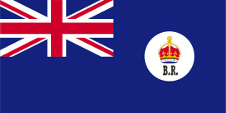
1892–1916, Gilbert Islands Protectorate,
Flag of the British Resident Commissioner,
ratio = 1:2,
Source, by: Flags of the World




1916–1969,
Union Flag → quasi National flag,
Flag of United Kingdom,
ratio = 1:2,
Source, by: Wikipedia (EN)





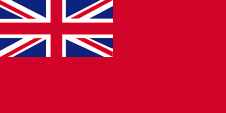
1916–1978,
Merchant flag,
ratio = 1:2,
Source, by: Flags of all Nations






1916–1971, Gilbert and Ellice Islands Colony,
Flag of the British Resident Commissioner,
ratio = 1:2,
Source, by: Flags of the World



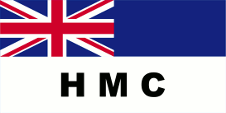
1916–1975, Gilbert and Ellice Islands Colony,
Customs flag,
ratio = 1:2,
Source, by: Flags of the World



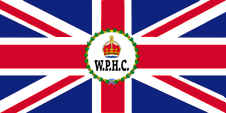
1877–1953,
Flag of the Western Pacific High Commissioner,
ratio = 1:2,
Source, by: Flags of the World



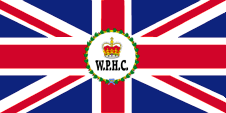
1953–1971,
Flag of the Western Pacific High Commissioner,
ratio = 1:2,
Source, by: Flags of the World



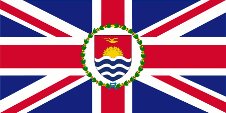
1972–1979, Gilbert and Ellice Islands Colony,
Flag of the Governor,
ratio = 1:2,
Source, by: Flags of the World



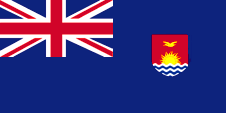
1937–1969, Gilbert and Ellice Islands Colony,
Flag of the government (state flag),
ratio = 1:2,
Source, by: Flags of the World




1969–1975, Gilbert and Ellice Islands Colony,
National and state flag,
ratio = 1:2,
Source, by: Flags of the World



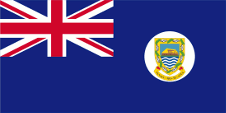
1975–1978, Ellice Islands Colony,
National and state flag,
ratio = 1:2,
Source, by: Flags of the World




1975–1978, Ellice Islands Colony,
Customs flag,
ratio = 1:2,
Source, by: Flags of the World




1978–1995, Tuvalu,
National and merchant flag,
ratio = 1:2,
Source, by: Flags of the World




1978–2015, Tuvalu,
Customs flag,
ratio = 1:2,
Source, by: Flags of the World



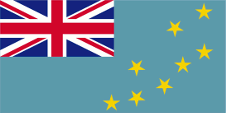
1995, Tuvalu,
National and merchant flag,
ratio = 1:2,
Source, by: Flags of the World



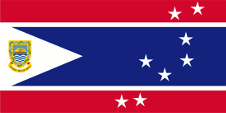
1995–1997, Tuvalu,
National and merchant flag,
ratio = 1:2,
Source, by: Flags of the World




From the middle of the 19th century onwards, United Kingdom felt responsible for the islands in the Pacific Ocean and from 1877 was appointed the "High Commissioner for the Western Pacific" in the region, who was responsible for coordinating the acquisition of the region. He appointed a British Resident Commissioner on some island groups in the Western Pacific, who worked locally in the interests of the British Crown by advising the existing local administrative structures. United Kingdom took possession of the Ellice Islands in 1892, a British Resident Commissioner was appointed and they were merged with the Gilbert Islands to form the crown colony of the Gilbert and Ellice Islands in 1916, so that the British flag flew over the islands from that year at the latest. On land, and until 1864 also at sea, individual citizens and the authorities represented their status as citizens or bodies of the United Kingdom by using the Union Jack, known as the Union Flag.
United Kingdom had introduced a flag system in 1864 in which:
• Warships use a so-called "White Ensign" (naval flag), a white flag often with a red St. George's cross throughout and with the Union Jack in the upper corner,
• Merchant ships use a so-called "Red Ensign" (also called "Civil Ensign" → citizen flag, the actual merchant flag), a red flag with the Union Jack in the upper corner, and
• Governmental ships use a "Blue Ensign" (flag of the government → the actual state flag), a blue flag with the Union Jack in the upper orner.
Since 1865, colonial government ships were permitted to use a Blue Ensign with a badge in the flying end. From this point on, only the British Union Jack was to be used for all other purposes on land and the usual red British merchant flag, the "Red Ensign", at sea. If the British Admiralty had granted the appropriate permission to one colony, merchant ships and private sailors from this colony were allowed to use a Red Ensign with the Bagde. This was not the case for the Gilbert and Ellice Islands. The respective governments should provide appropriate bagdes.
Such a badge was often a regional landscape representation placed on a disk, often showed ships, historical events or could just be a kind of logo. Very often a badge also showed the name of the country or a motto. However, some possessions had a coat of arms right from the start, or received their own coat of arms over the years and the badge was abolished. In order to ensure a largely uniform appearance in the flying end of the flags, coats of arms and other symbols were displayed on a white disk the same size as the earlier badges. But there were exceptions here, as some colonies did not use this white disk and placed their coat of arms or just the shield – sometimes enlarged – directly on the flag cloth. As early as the 1940s, the white discs were removed and the coat of arms was placed directly or enlarged. This transition process occurred gradually, never simultaneously and completely. In some British possessions flags with the white disc are still in use, in others they are no longer used and in some areas both variants exist side by side.
From 1937, the government of the Gilbert and Ellice Islands, as a British colony, used its own blue British official flag (Blue Ensign) with a badge in the waving part of the flag. The badge was the colony's heraldic shield, showing a yellow frigatebird on a red background above a rising yellow sun, with three wavy blue and white stripes underneath. From 1969 onwards, this flag was also allowed as a national flag, i.e. for use by everyone and also on land. The Ellice Islands were separated at their own request in 1975 and became an independent British colony, the Blue Ensign of it showed the country's coat of arms on a white disk in the waving end. The Gilbert Islands colony retained the frigatebird escutcheon.
United Kingdom granted the Ellice Islands independence as the state "Tuvalu" on 1st of October in 1978 within the framework of the Commonwealth; the British monarch remained as head of state, who was represented locally by the Governor General. The today's flag was introduced on the occasion of independence. The design was the winner of a competition and came from the teacher Vione Natane. It shows nine yellow five-pointed stars on a light blue background and the British Union Jack in the upper corner. The light blue represents the sea, the nine yellow stars represent the archipelago and its location in the ocean, with west at the top on the flag. The design remained unchanged, except in 1995, when for three months only eight stars were displayed on the flag. The number of islands or atolls in the country has repeatedly led to discussions about the country's name, which in turn has led to questions about the number of stars on the flag and the number of snails and leaves on the country's coat of arms. The name "Tuvalu" means "eight together" in Tuvaluan, which refers to the eight islands of the archipelago, at least from the point of view of the Tuvaluans. There are actually nine islands or atolls. On the one hand, the discrepancy is attributed to the fact that the ninth island is the island of "Niulakita", which is very small and has only been inhabited since 1949, and is historically considered "uninhabited", so to speak. On the other hand, the atoll of "Nui" is inhabited by Gilbertese-speaking Micronesians, who, as they are linguistically and ethnically more likely to belong to the unpopular neighbouring state of Kiribati, are considered foreigners and the island is therefore not counted. The colours of the flag suggest that Tuvalu's colours and colour-shades are based on the British color system, therefore the colour system of the British Ministry of Defense is valid. This means for red = Pantone 186 c, for deep yellow = Pantone 116 c, for dark blue = Pantone 280 c and for azure blue = Pantone 549 c.
An attempt to introduce a new flag was started on 1st of October in 1995. The new flag was intended to symbolize Tuvalu's planned path to republic and final separation from United Kingdom. It showed a red flag with a wide blue central stripe, with narrow white stripes, and in the blue stripe a white wedge on the mast, in the middle of which the national coat of arms was placed. Eight white five-pointed stars were arranged across the waving part of the flag, similar to today's flag. The attempt failed miserably; the flag, like the associated policies, met with massive popular rejection. On 10th of July in 1997, the old flag was reintroduced, with nine stars.
Source:
Flags of the World,
Die Welt der Flaggen,
Flags of all Nations,
Wikipedia (EN),
Handbuch der geographischen Namen,
Volker Preuß

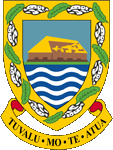
since 1976,
Coat of arms of Tuvalu,
Source, by: Flags of the World

The today’s coat of arms of Tuvalu was awarded on 3rd of December in 1976. It shows in the middle a Maneapa (common house) and below blue and white waves. The golden border around the scutcheon shows eight Mitra Snails by turns with banana leafs. The eight snails and leafs stand for the name "Tuvalu", what means "eight together". Below a banner with the motto of the country. It is: "Tuvalu mo te Atua" → "Tuvalu for God". The number of islands or atolls in the country has repeatedly led to discussions about the country's name, which in turn has led to questions about the number of stars on the flag and the number of snails and leaves on the country's coat of arms. The name "Tuvalu" means "eight together" in Tuvaluan, which refers to the eight islands of the archipelago, at least from the point of view of the Tuvaluans. There are actually nine islands or atolls. On the one hand, the discrepancy is attributed to the fact that the ninth island is the island of "Niulakita", which is very small and has only been inhabited since 1949, and is historically considered "uninhabited", so to speak. On the other hand, the atoll of "Nui" is inhabited by Gilbertese-speaking Micronesians, who, as they are linguistically and ethnically more likely to belong to the unpopular neighbouring state of Kiribati, are considered foreigners and the island is therefore not counted.
Source:
Flags of the World,
Die Welt der Flaggen,
Wikipedia (EN),
Handbuch der geographischen Namen,
Volker Preuß

Location:
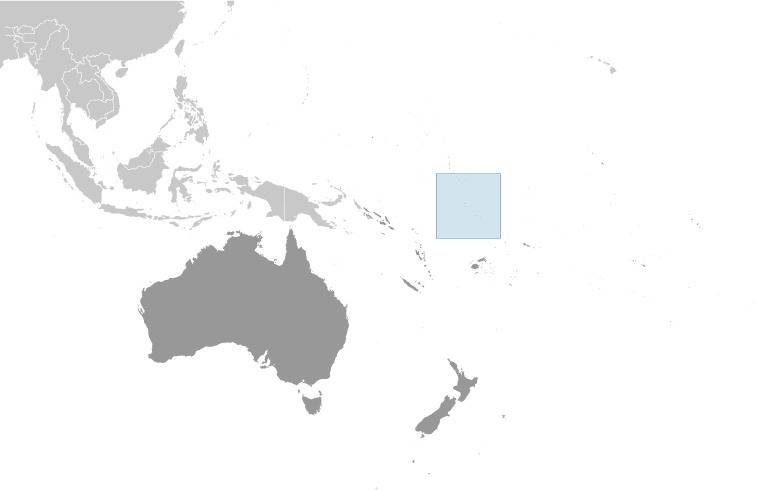
Source: CIA World Factbook
Map of the country:
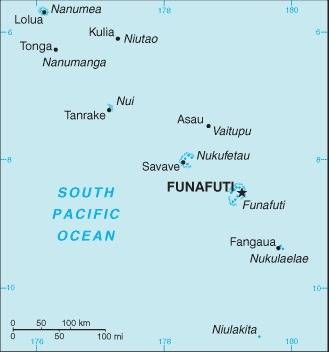
Source: CIA World Factbook

Map: Volker Preuß

Area: 10 square miles, thereof Funafuti (Ellice Island) 1 sq.mi., Nanumea (St. Augustine) 1,6 sq.mi., Nui (Netherland Island) 1,1 sq.mi., Nukufetau (Peyster Island) 1,1 sq.mi., Nukulaelae (Mitchell Island) 0,8 sq.mi., Vaitupu (Tracy Island) 2,1 sq.mi., Nanumanga (Hudson Island) 1,1 sq.mi., Niulakita (Sophia Island) 0,2 sq.mi., Niutao (Lynx I., Speiden I.) 1 sq.mi.
Inhabitants: 10.507 (2017), thereof 97 % Polynesians, 3 % Mikronesians (mostly on Nui Island)
Religions: 91% Protestant, 1,5 % Bahai, 0,9 % Mormons, 0,5 % Roman Catholic
Density of Population: 1.047 inh./sq.mi.
Capital: Funafuti, 6.320 inh. (2017)
official Languages: Tuvaluan (Polynesian dialect), English
other Languages: Samoan (Polynesian dialect), Gilbertese (Micronesian dialect)
Currency: 1 Australian Dollar (AUD, A$) = 100 Cents, 1 Tuvaluan Dollar (TVD, $T, TV$) = 100 Cents
Time Zone: GMT + 12 h
Source: Wikipedia (D)

antiquity · settlement by Polynesians from Samoa and Tokelau
1568 · discovery of the islands (Nui Island) by the Spanish seafarer Alvaro de Mendaña
1595 · Alvaro de Mendaña visits the archipelago again (Niulakita Island)
1764 · re-discovery by the British seafarer John Byron, he named the islands "Lagoon Islands"
1781 · discovery of Nanumanga Island by the Spanish seafarer Francisco Maurelle
1819 · discovery of Nukefetau Island and Funafuti Island by the British seafarer Arent de Peyster
1821 · discovery of Nukulaelae Island by the US-american seafarer George Barrett, re-discovery of Niulakita Island
1841 · the US-american explorer Charles Wilkes visits and explores the islands, penetration of diseases, in the afteryears hunt for slaves, potent reducing of population
1865 · start of mission
1880 · the German Trade and Plantation Society establishes copra plantations on four islands
1892 · United Kingdom takes possession of the Ellice Islands, merging them with the Gilbert Islands (today’s Kiribati) to form the Gilbert and Ellice Islands Protectorate
1916 · the Gilbert and Ellice Islands protectorate becomes a British crown colony
1972 · wishes for autonomy (separation from the Gilbert Islands)
1st of October 1975 · separation of the Ellice Islands from the Gilbert Islands, the Ellice Islands become an own colony under an own governor
1st of October 1978 · United Kingdom grants the independence within the framework of the Commonwealth
1986 · a plebiscite for the transformation into a republic fails
1st of September 2000 · Tuvalu becomes a full member of the Commonwealth
5th of September 2000 · Tuvalu becomes a member of the UNO
2008 · a plebiscite for the transformation into a republic fails
Source:
Atlas zur Geschichte,
Wikipedia (D),
Discovery '97

The number of islands or atolls in the country has repeatedly led to discussions about the country's name, which in turn has led to questions about the number of stars on the flag and the number of snails and leaves on the country's coat of arms. The name "Tuvalu" means "eight together" in Tuvaluan, which refers to the eight islands of the archipelago, at least from the point of view of the Tuvaluans. There are actually nine islands or atolls. On the one hand, the discrepancy is attributed to the fact that the ninth island is the island of "Niulakita", which is very small and has only been inhabited since 1949, and is historically considered "uninhabited", so to speak. On the other hand, the atoll of "Nui" is inhabited by Gilbertese-speaking Micronesians, who, as they are linguistically and ethnically more likely to belong to the unpopular neighbouring state of Kiribati, are considered foreigners and the island is therefore not counted. The old name "Ellice Islands" was transferred from the main island, which was discovered in 1819 by the British navigator Arent de Peyster, to the entire archipelago. Edward Ellice was the owner of Peyster's ship.
Source:
Handbuch der geographischen Namen,
1.) Wikipedia (EN),
2.) Wikipedia (EN),
Volker Preuß


![]()
































